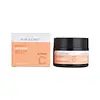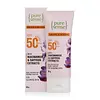What's inside
What's inside
 Key Ingredients
Key Ingredients

 Benefits
Benefits

 Concerns
Concerns

 Ingredients Side-by-side
Ingredients Side-by-side

Water
Skin ConditioningGlycerin
HumectantPropylene Glycol
HumectantCaprylic/Capric Triglyceride
MaskingHelianthus Annuus Seed Oil
EmollientIsononyl Isononanoate
EmollientSqualane
EmollientSteareth-21
CleansingButyrospermum Parkii Oil
Emollient3-O-Ethyl Ascorbic Acid
Skin ConditioningSteareth-2
EmulsifyingTocopheryl Acetate
AntioxidantButylene Glycol
HumectantCetearyl Alcohol
EmollientGlyceryl Stearate
EmollientPanthenol
Skin ConditioningSaccharide Isomerate
HumectantSodium Hyaluronate
HumectantHexylene Glycol
EmulsifyingPhenoxyethanol
PreservativeSodium Acrylate/Sodium Acryloyldimethyl Taurate Copolymer
Emulsion StabilisingRubus Chamaemorus Seed Extract
Skin ConditioningOlea Europaea Oil Unsaponifiables
Skin ConditioningIsohexadecane
EmollientAllantoin
Skin ConditioningPolygonum Cuspidatum Root Extract
AntioxidantArginine
MaskingParfum
MaskingSodium Polyacrylate
AbsorbentXanthan Gum
EmulsifyingCentella Asiatica Extract
CleansingPolysorbate 80
EmulsifyingCamellia Sinensis Leaf Extract
AntimicrobialChamomilla Recutita Flower Extract
MaskingGlycyrrhiza Glabra Root Extract
BleachingRosmarinus Officinalis Leaf Extract
AntimicrobialScutellaria Baicalensis Root Extract
AstringentSorbitan Oleate
EmulsifyingCitric Acid
BufferingSodium Citrate
BufferingSodium Hydroxide
BufferingEthylhexylglycerin
Skin ConditioningWater, Glycerin, Propylene Glycol, Caprylic/Capric Triglyceride, Helianthus Annuus Seed Oil, Isononyl Isononanoate, Squalane, Steareth-21, Butyrospermum Parkii Oil, 3-O-Ethyl Ascorbic Acid, Steareth-2, Tocopheryl Acetate, Butylene Glycol, Cetearyl Alcohol, Glyceryl Stearate, Panthenol, Saccharide Isomerate, Sodium Hyaluronate, Hexylene Glycol, Phenoxyethanol, Sodium Acrylate/Sodium Acryloyldimethyl Taurate Copolymer, Rubus Chamaemorus Seed Extract, Olea Europaea Oil Unsaponifiables, Isohexadecane, Allantoin, Polygonum Cuspidatum Root Extract, Arginine, Parfum, Sodium Polyacrylate, Xanthan Gum, Centella Asiatica Extract, Polysorbate 80, Camellia Sinensis Leaf Extract, Chamomilla Recutita Flower Extract, Glycyrrhiza Glabra Root Extract, Rosmarinus Officinalis Leaf Extract, Scutellaria Baicalensis Root Extract, Sorbitan Oleate, Citric Acid, Sodium Citrate, Sodium Hydroxide, Ethylhexylglycerin
Water
Skin ConditioningCyclopentasiloxane
EmollientDimethicone Crosspolymer
Emulsion StabilisingGlycerin
HumectantEthylhexyl Methoxycinnamate
UV AbsorberZinc Oxide
Cosmetic ColorantPEG-10 Dimethicone
Skin ConditioningTriethoxycaprylylsilane
Phenylbenzimidazole Sulfonic Acid
UV AbsorberPotassium Chloride
Titanium Dioxide
Cosmetic ColorantHydrogen Dimethicone
Caprylic/Capric Triglyceride
MaskingDisteardimonium Hectorite
StabilisingPropylene Carbonate
SolventNiacinamide
SmoothingCrocus Sativus Callus Extract
AntioxidantTocopheryl Acetate
AntioxidantSodium Ascorbyl Phosphate
AntioxidantMagnesium Sulfate
Phenoxyethanol
PreservativeEthylhexylglycerin
Skin ConditioningSodium Hydroxide
BufferingParfum
MaskingPEG-30 Dipolyhydroxystearate
EmulsifyingAllantoin
Skin ConditioningDisodium EDTA
Water, Cyclopentasiloxane, Dimethicone Crosspolymer, Glycerin, Ethylhexyl Methoxycinnamate, Zinc Oxide, PEG-10 Dimethicone, Triethoxycaprylylsilane, Phenylbenzimidazole Sulfonic Acid, Potassium Chloride, Titanium Dioxide, Hydrogen Dimethicone, Caprylic/Capric Triglyceride, Disteardimonium Hectorite, Propylene Carbonate, Niacinamide, Crocus Sativus Callus Extract, Tocopheryl Acetate, Sodium Ascorbyl Phosphate, Magnesium Sulfate, Phenoxyethanol, Ethylhexylglycerin, Sodium Hydroxide, Parfum, PEG-30 Dipolyhydroxystearate, Allantoin, Disodium EDTA
 Reviews
Reviews

Ingredients Explained
These ingredients are found in both products.
Ingredients higher up in an ingredient list are typically present in a larger amount.
Allantoin is a soothing ingredient known for its protective and moisturizingg properties. Because of this, it is often added to products with strong active ingredients.
Studies show higher concentrations of this ingredient can promote wound healing.
Though it can be derived from the comfrey plant, allantoin is produced synthetically for cosmetic products to ensure purity.
Learn more about AllantoinThis ingredient is an emollient, solvent, and texture enhancer. It is considered a skin-softener by helping the skin prevent moisture loss.
It helps thicken a product's formula and makes it easier to spread by dissolving clumping compounds.
Caprylic Triglyceride is made by combining glycerin with coconut oil, forming a clear liquid.
While there is an assumption Caprylic Triglyceride can clog pores due to it being derived from coconut oil, there is no research supporting this.
Learn more about Caprylic/Capric TriglycerideEthylhexylglycerin (we can't pronounce this either) is commonly used as a preservative and skin softener. It is derived from glyceryl.
You might see Ethylhexylglycerin often paired with other preservatives such as phenoxyethanol. Ethylhexylglycerin has been found to increase the effectiveness of these other preservatives.
Glycerin is already naturally found in your skin. It helps moisturize and protect your skin.
A study from 2016 found glycerin to be more effective as a humectant than AHAs and hyaluronic acid.
As a humectant, it helps the skin stay hydrated by pulling moisture to your skin. The low molecular weight of glycerin allows it to pull moisture into the deeper layers of your skin.
Hydrated skin improves your skin barrier; Your skin barrier helps protect against irritants and bacteria.
Glycerin has also been found to have antimicrobial and antiviral properties. Due to these properties, glycerin is often used in wound and burn treatments.
In cosmetics, glycerin is usually derived from plants such as soybean or palm. However, it can also be sourced from animals, such as tallow or animal fat.
This ingredient is organic, colorless, odorless, and non-toxic.
Glycerin is the name for this ingredient in American English. British English uses Glycerol/Glycerine.
Learn more about GlycerinParfum is a catch-all term for an ingredient or more that is used to give a scent to products.
Also called "fragrance", this ingredient can be a blend of hundreds of chemicals or plant oils. This means every product with "fragrance" or "parfum" in the ingredients list is a different mixture.
For instance, Habanolide is a proprietary trade name for a specific aroma chemical. When used as a fragrance ingredient in cosmetics, most aroma chemicals fall under the broad labeling category of “FRAGRANCE” or “PARFUM” according to EU and US regulations.
The term 'parfum' or 'fragrance' is not regulated in many countries. In many cases, it is up to the brand to define this term.
For instance, many brands choose to label themselves as "fragrance-free" because they are not using synthetic fragrances. However, their products may still contain ingredients such as essential oils that are considered a fragrance by INCI standards.
One example is Calendula flower extract. Calendula is an essential oil that still imparts a scent or 'fragrance'.
Depending on the blend, the ingredients in the mixture can cause allergies and sensitivities on the skin. Some ingredients that are known EU allergens include linalool and citronellol.
Parfum can also be used to mask or cover an unpleasant scent.
The bottom line is: not all fragrances/parfum/ingredients are created equally. If you are worried about fragrances, we recommend taking a closer look at an ingredient. And of course, we always recommend speaking with a professional.
Learn more about ParfumPhenoxyethanol is a preservative that has germicide, antimicrobial, and aromatic properties. Studies show that phenoxyethanol can prevent microbial growth. By itself, it has a scent that is similar to that of a rose.
It's often used in formulations along with Caprylyl Glycol to preserve the shelf life of products.
Sodium Hydroxide is also known as lye or caustic soda. It is used to adjust the pH of products; many ingredients require a specific pH to be effective.
In small amounts, sodium hydroxide is considered safe to use. However, large amounts may cause chemical burns due to its high alkaline.
Your skin has a natural pH and acid mantle. This acid mantle helps prevent harmful bacteria from breaking through. The acid mantle also helps keep your skin hydrated.
"Alkaline" refers to a high pH level. A low pH level would be considered acidic.
Learn more about Sodium HydroxideTocopheryl Acetate is AKA Vitamin E. It is an antioxidant and protects your skin from free radicals. Free radicals damage the skin by breaking down collagen.
One study found using Tocopheryl Acetate with Vitamin C decreased the number of sunburned cells.
Tocopheryl Acetate is commonly found in both skincare and dietary supplements.
Learn more about Tocopheryl AcetateWater. It's the most common cosmetic ingredient of all. You'll usually see it at the top of ingredient lists, meaning that it makes up the largest part of the product.
So why is it so popular? Water most often acts as a solvent - this means that it helps dissolve other ingredients into the formulation.
You'll also recognize water as that liquid we all need to stay alive. If you see this, drink a glass of water. Stay hydrated!
Learn more about Water